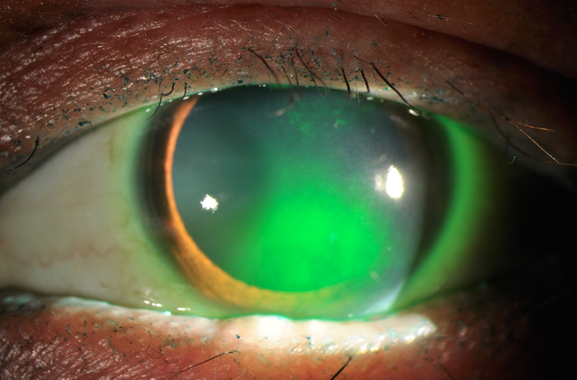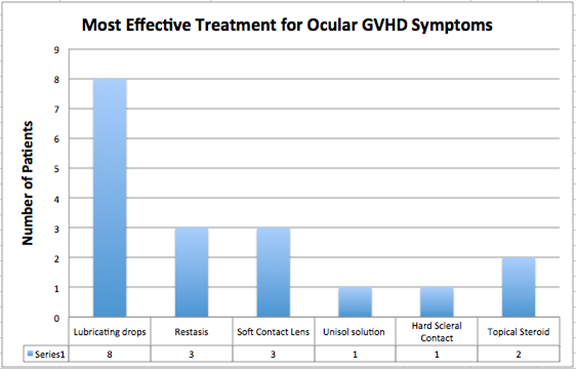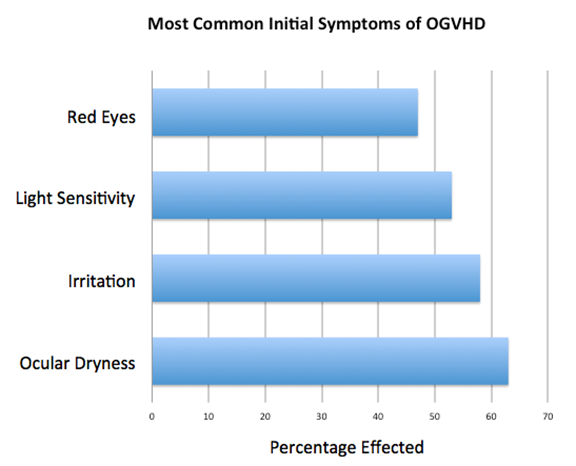Case Series
Volume 1 Issue 1 - 2016
Ocular Graft Versus Host Disease: The Patient Experience
Department of Ophthalmology, University of South Florida Eye Institute, USA
*Corresponding Author: Maximilian Padilla MD, Department of Ophthalmology, University of South Florida Eye Institute, USA.
Received: August 08, 2016; Published: December 29, 2016
Abstract
Purpose: Graft versus host disease (GVHD) is a destructive complication causing adverse systemic and ocular effects that occurs in patients following a bone marrow transplant. Through patient surveys we identified the initial presenting ocular symptoms, compared effectiveness of common treatments, and investigated the functionality of patients affected by this destructive process using the National Institutes of Health Eye Score.
Methods: National Institutes of Health Eye Score
Results: In the patients surveyed from August 2013 to May 2014 demonstrated: the most common initial symptoms were ocular dryness (63%), followed by general irritation (58%), light sensitivity (53%), and red eyes (47%). The most successful overall treatments were: lubricating eye drops (44% of patients), and contact lenses (17%). Patients treated with Restasis (cyclosporine) for their symptoms reported: no improvement (53%), improvement (37%), no change (5%), allergic reaction (5%). The Level of debilitation reported showed that over a third of patients (36%) self reported their symptoms as being severe according to the National Institutes of Health Eye Score even after being treated. Correlation coefficients were analyzed and showed a strong connection between severity and commonality of symptoms in the categories of dryness (r = 0.9528), light sensitivity (r = 0.7658) and red eyes (r = 0.8039), along with moderate correlation with ocular irritation (r = 0.7081).
Conclusions: Ocular Graft vs Host disease is severely debilitating to over one third of patients affected by it. The most common presenting symptom is dry eyes. Restasis was found to be ineffective in the majority of patients. The most effective treatment overall was lubricating eye drops.
Keywords: Cornea; Immunology; Graft Versus Host Disease; Dry Eyes
Abbreviations: GVHD: Graft versus host disease; OGVHD: Ocular Graft vs Host disease
Introduction
Graft vs Host Disease (GVHD) is a multifactorial disease that is immune mediated and has multiple systemic as well as ocular effects. The pathology arises when the donor and recipient immune cells interact, and the donor T cells attack the native tissues including those of the eye. Effects can be severe enough to cause debilitation and blindness. The incidence of Ocular Graft vs Host Disease (OGVHD) has been measured to be 40-60% in patients receiving bone marrow transplants (Shikari). The signs, symptoms, and exam findings of OGVHD have been well documented in the past.
The purpose of our study, and what makes this case series unique, is that we investigate the patients experience with the ocular symptoms of their illness by patient surveys. Through a detailed questionnaire given to patients in cornea clinic at the University of South Florida, we identified the most common presenting ocular symptoms, the most effective of 6 common treatments, and ascertained patient satisfaction and effectiveness of Restasis (cyclosporine) treatment.
As with any ocular condition with sight threatening potential, patients quality of life can be severely compromised by their disease. Previous studies investigating the debilitating effects on patients with ocular diseases including: Type-1 diabetes mellitus associated retinal disease, branch retinal vascular occlusion, and Behcets disease have found through their surveys a similar level of debilitation in those diseases as with OGVHD (Riemens). This case series questionnaire included the patients ranking their level of debilitation based on the National Institutes of Health Eye Score after their treatment.
Materials and Methods
This study was conducted at the University of South Florida (USF) Eye Institute. Cornea clinic patients were identified as having ocular graft disease after evaluation in clinic, on chart reviews, and through referrals from the Moffitt Cancer Center, a nationally recognized cancer treatment hospital within the health campus. Patients volunteered to complete a multi-question survey during their clinic appointment, and signed a consent form for the study which reiterated and guaranteed de identification and confidentiality. Once the surveys were collected, the data was used to calculate the patient satisfaction with the various treatments, severity of symptoms, and the most common patient reported initial symptoms. A correlation coefficient was used to compare the reported severity of symptoms with the most commonality of symptoms to show which were the most devastating. To study the patients level of debilitation from their disease after ocular treatment was begun, we used the National Institutes of Health Eye Score and had patients rank their level of debilitation as either: none, low, medium, or severe.
Results
The overall most common symptoms of OGVHD were ocular dryness (63% of patients), followed by general irritation (58%), light sensitivity (53%), and red eyes (47%). When the patients were asked to characterize the severity of symptoms, a correlation coefficient showed a strong connection between severity and commonality of symptoms in the categories of dryness (r = 0.9528), light sensitivity (r = 0.7658) and red eyes (r = 0.8039), along with moderate correlation with ocular irritation (r = 0.7081). Investigation into the most successful overall treatments showed the most patient benefit from: lubricating eye drops (44% of patients), contact lenses (17%), Restasis (17%), Unisol (5%), scleral contact lenses (5%), and topical steroids (12%). Patients treated with Restasis for their symptoms showed: no improvement (53%), improvement (37%), no change (5%), allergic reaction (5%). Self reported functionality was noted to be severe in over one third of patients (36%) according to the National Institutes of Health Eye Score even after undergoing treatment.
Figure 1: Slit Lamp Photograph of OGVHD patient illustrating common exam findings including: diffuse cornea fluorescence staining from epithelial damage, decreased tear film, poor meibomian gland appearance, and loss of lashes.
Table 1: Based on patient survey the most effective treatment for the symptoms of OGVHD was weighted towards lubricating drops, followed by Restasis and Soft Contact Lenses.
Table 2: When asked to describe their initial symptoms when first diagnosed with OGVHD the majority of complaints included dry eyes and irritation.
Discussion
Graft vs host disease is a complex disease process with debilitating systemic and ocular effects. While severity is often wide-ranging, it has the potential to be very disabling in terms of functionality. Often times, systemic symptoms may be under control but progression of ocular symptoms is common. In our patient population the length of time from the initial diagnosis of GVHD ocular effects varied widely from 1 week to 2 years after initial diagnosis after their initial bone marrow transplant. This study, which specifically focuses on the experience from a patient perspective, highlights how much ocular symptoms can impact their lives and functionality, with over one third of OGVHD patients reporting severely debilitating symptoms. This has a large impact on not only their quality of life, but also on their economic and social well-being which can be quite saddening given that the intial goal of treatment with a bone marrow transplant was done in hopes of extending or even saving their life.
Through statistical analysis using correlation coefficients, we found that the most severe symptoms were ocular dryness, light sensitivity, and red eyes. Interestingly the most effective overall treatment noted by patients was frequent artificial tears. This data highlights a preventative option for patient to initiate artificial treatment in hopes of delaying the debilitating onset of OGVHD or decreasing symptoms to improve quality of life of these often fragile patients.
A common treatment for dry eyes that has been incorporated into the treatment for many patients with OGVHD has been Restasis (cyclosporine). Previous studies have shown that there is a marked improvement in the patients’ dry eye disease based on exam findings (Rao). Our case series, which focused on the patient’s perspective, indicated that only 37% of patients felt that their symptoms were improved with Restasis despite the examination findings.
Conclusion
Our hope is that the results of this study will provide more insight into the initial patients experience as we look into the symptoms of ocular GVHD and allow for a better understanding of the performance and functionality of patients suffering from the devastating chronicity of this disease, and the best treatments for their symptoms.
Conflict of interest
None of the authors have any conflicts of interests
None of the authors have any conflicts of interests
References
- Espana EM., et al. “Graft versus host disease: clinical evaluation, diagnosis and management”. Graefe's Archive for Clinical and Experimental Ophthalmology 251.5 (2013): 1257-1266.
- Shikari H., et al. “Ocular graft-versus-host disease: a review”. Survey of Ophthalmology 58.3 (2013): 233-251.
- Riemens A., et al. “Impact of ocular graft-versus-host disease on visual quality of life in patients after allogeneic stem cell transplantation: questionnaire study”. Acta Ophthalmology 92.1 (2013): 82-87.
- Rao SN and Rao RD. “Efficacy of topical cyclosporine 0.05% in the treatment of dry eye associated with graft versus host disease”. Cornea 25.6 (2006): 674-678.
Citation:
Maximilian Padilla., et al. “Ocular Graft Versus Host Disease: The Patient Experience”. Ophthalmology and Vision Science 1.1
(2016): 4-7.
Copyright: © 2016 Maximilian Padilla., et al. This is an open-access article distributed under the terms of the Creative Commons Attribution License, which permits unrestricted use, distribution, and reproduction in any medium, provided the original author and source are credited.






































 Scientia Ricerca is licensed and content of this site is available under a Creative Commons Attribution 4.0 International License.
Scientia Ricerca is licensed and content of this site is available under a Creative Commons Attribution 4.0 International License.